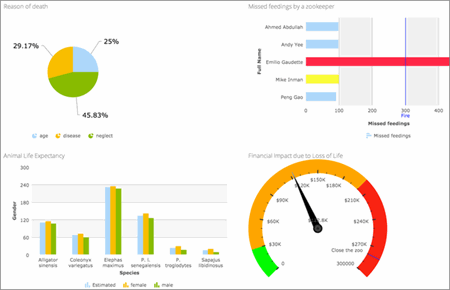Application Express and the Content Security Policy
Valid from Pega Version 7.1.7
Application Express copies (if defined) the Content Security Policy (CSP) name (pyContentSecurityPolicyName) from the built-on application in a new application. It also sets the CSP mode (pyContentSecurityPolicyMode) to report. The values appear in the Content Security area on the application rule's Integration & Security tab.
When checking an application in the DCO Compatibility tool, a warning appears if the CSP name is missing.
Report Viewer provides simplified user experience
Valid from Pega Version 7.1.7
In the Report Viewer, improvements simplify the user experience when working with reports. Column headers display initial sort order and type, and you can hover over a column header to display and use its context menu, which includes options for ad-hoc sorting and filtering. Developers can specify various pagination modes and set an option to keep the header in view while users scroll through the report.
For more information, see Report Viewer.
Enhanced BIX file naming
Valid from Pega Version 7.1.7
To help clarify file names, BIX extract output files and manifest files can now contain parameters. Parameters can include the rule name, the extract's run time and date, and a unique run sequence number. Special characters such as spaces, hyphens, or number signs (#) in the output or manifest file name are converted to underscores. In addition, the pxExtractIdentifier and pxExtractDateTime columns have been added to the .csv output file.
For more information, see Extracting data with BIX and Extract rules - completing the File Specification tab.
List view and summary view reports might not display in HTML5-compliant browsers
Valid from Pega Version 7.1.7
List view and summary view reports use framesets to provide a view of drill-down reports. HTML5 does not support framesets, so these reports might not display well, or at all, in versions of browsers that are compliant with HTML5.
To prevent display issues, re-create the custom list view and summary view reports that you need as report definition reports. Standard management reports are already available as report definition reports.
As of Pega 7.2, list view and summary view rules are deprecated. For more information, see Discontinued support for list view and summary view rules.
Enhanced chart control improves displaying data as a chart
Valid from Pega Version 7.1.7
The renewed chart control has an improved properties panel and provides HTML5-compliant pie, column, bar, area, line, and gauge charts. The chart source can be a report definition, a clipboard page, or a data page. You can customize basic and threshold colors, borders, line widths, labels, and other chart elements. A preview on the property panel instantly displays the effects on the chart of property changes you make.
For more information, see Harness and section forms - Adding a chart.

HTML5-compliant chart types
Password hashing using SHA-256/SHA-512
Valid from Pega Version 7.1.7
Password hashing using the SHA-256 and SHA-512 hash functions is available for use during the the Pega 7 authentication process with operator, ruleset, and update lock passwords. The SHA-256/SHA-512 hash functions join the previously available MD5 and SHA-1 hash functions.
Using SHA-256/SHA-512 hashing when creating or upgrading a password hash results in increased complexity of the hash, making it extremely difficult and time-consuming to determine hashed password values stored in a database.
Note that once you have updated your system to Pega 7.1.7 and have applied password hashing using the SHA-256/SHA-512 hash functions, reverting back to a previous version of Pega 7 is not advised as this causes hashed passwords using SHA-256/SHA-512 to fail.
See About password hashing for more information.
View status of custom search indexes
Valid from Pega Version 8.1
Custom search indexes are special purpose indexes that are created and managed outside of Pega Platform™. You can view the status of custom search indexes on the Search landing page to see whether they are complete. This information is useful for troubleshooting and can help you determine whether to rebuild the index.
For more information, see Checking search index status.
Support for OAuth 2.0 authorization code grant type
Valid from Pega Version 8.1
Pega Platform™ now supports the OAuth 2.0 authorization code grant type, which allows Pega Platform to act as an OAuth 2.0 access token provider for native applications on mobile and other devices. By using the authorization code grant type for mobile clients, you no longer need to implement a variety of standards for various authentication providers. The authorization code grant type also supports the Proof Key for Code Exchange standard (PKCE) for securing public clients.
For more information, see Creating and configuring an OAuth 2.0 client registration.
Use client-based access control to support EU GDPR requirements
Valid from Pega Version 8.1
You can use client-based access control (CBAC) to satisfy the data privacy requirements of the European Union General Data Protection Regulation (GDPR) and similar regulations. By using client-based access control, you can identify the personal data of clients and automatically process requests to view, update, or remove the data in a secure manner. You can also enforce restrictions on the use of this data in application functions.
For more information, see Client-based access control.
Ability to generate a dedicated search index for a case type
Valid from Pega Version 8.1
You can generate a dedicated search index for a case type. Using a dedicated index makes reporting faster without putting additional requirements on the database.
For more information, see Including indexed data during case search.

